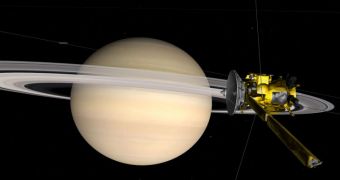Officials with the American space agency recently announced the launch of a new website, which they said is dedicated to exploring the solar system in a virtual environment. Users will be treated to a panoply of images and animations that will bring neighboring celestial bodies closer than ever before.
This interactive Web-based tool is called “Eyes on the Solar System” and is heavily based on technologies used to create video games. NASA also made use of its past experience with creating sky surveys and models to create an amazing 3D environment.
Perhaps one of the most interesting aspects this website has to offer is giving users the opportunity to trek through the solar system alongside famous NASA missions, such as the Cassini orbiter around Saturn, the New Horizons mission to Pluto, or the Dawn space probe around the asteroid Vesta.
Actual space mission data were included in the new tool as well. All planet locations and spacecraft maneuver details that are listed on the screen are valid, real telemetry information that the missions themselves transmitted back to Mission Control.
Models of planets, moons, asteroids, comets and spacecraft are rendered and displayed using the Unity game engine. Given its capabilities, this engine is able to showcase the objects as they move through the solar system as if in real time.
Keyboard and mouse controls are available to users, so that they can move their virtual point of view anywhere in the solar system. The Web application can only be used if a free browser plug-in is installed. The tool is available at the Eyes on the Solar System website.
“This is the first time the public has been able to see the entire solar system and our missions moving together in real time. It demonstrates NASA's continued commitment to share our science with everyone,” NASA official Jim Green explained.
He holds an appointment as the director of the space agency's Planetary Science Division, at the agency's Headquarters in Washington. The expert added that upcoming space missions will be included in the website as well.
Some of these missions include the Gravity Recovery and Interior Laboratory (GRAIL) mission to the Moon and the Mars Science Laboratory (MSL) Curiosity rover. Both will launch later this year.
“You are now free to move about the solar system. See what NASA's spacecraft see – and where they are right now – all without leaving your computer,” expert Blaine Baggett added.
The official holds an appointment as the executive manager in the Office of Communication and Education at the NASA Jet Propulsion Laboratory (JPL) in Pasadena, California. The JPL is a division of the California Institute of Technology (Caltech).
Eyes on the Solar System and an introduction video are available here.
Updates on new features are available through the tool's Twitter account.

 14 DAY TRIAL //
14 DAY TRIAL //